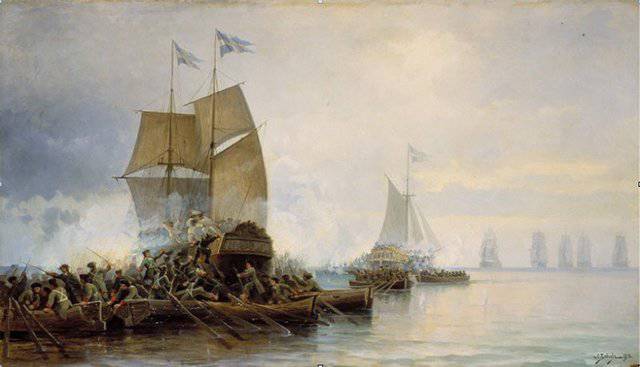Fight at the mouth of the Neva and the approval of Russia on the Baltic Sea

On May 18, 1703, a Russian detachment defeated the ships of the Swedish squadron of Vice Admiral Numers. This day is considered the founding date of the Baltic fleet. This victory forced the Swedish command to withdraw the squadron and forever leave the mouth of the Neva. Russia took possession of the entire Neva and got access to the Gulf of Finland. To protect him, Tsar Peter I on May 27, 1703 laid a fortress on the island of Yanni-Sari (Hare Island). Thus was founded the Peter and Paul Fortress and the city of St. Petersburg - the first Russian port on the Baltic Sea.
During the Northern War, the successful actions of the Russian troops under the command of Field Marshal Boris Sheremetev allowed Russia to establish itself in Ingria and proceed to the purification of Lake Ladoga and Lake Peipsi, where the Swedish ships were cruising. The Swedish Navy contributed to its ground forces and impeded the advancement of Russian troops. The Russians compensated the lack of funds (warships were only built) by courage and resourcefulness. An invaluable role in the fight against the Swedish naval forces was played by detachments of small river vessels (boats, carbas, boats, etc.), they were used as transports before the war, transporting various cargoes along rivers and lakes. Teams of soldiers were planted on the river vessels. It is clear that in their fighting qualities they could not resist the Swedish warships, which were armed with 10-20 guns and had teams of well-trained sailors. The Swedish command was confident in their abilities and did not expect serious opposition from the Russians on the water. But the Swedes underestimated the ingenuity, courage and fortitude of the Russians. So, in May, the 1702 of the year in a narrow strait that connected the Chudskoye and the Pskov Lakes, a detachment of Russian ships stumbled upon a Swedish squadron led by Commander Lescherna. A fierce battle began: the Swedes showered Russian carbas with nuclei, and gun shots rang out. Several Russian ships were defeated. However, the Russians did not retreat in their small craft and stubbornly went on the attack. They were able to take on board the yacht "Flundran", and then "Vivat" and "Watchman". Russian squad broke into Lake Peipsi.
There were battles on Lake Ladoga. 15 June 1702, the Russian ships under the command of Colonel Ostrovsky attacked the squadron of Vice Admiral Numers at the mouth of the Crow River. The Swedes went ashore and plundered the surrounding villages. Russian soldiers damaged the Joy’s flagship brigantine and forced the Swedes to retreat. Soon, a Russian detachment under the leadership of Colonel Tyrtov from 30 ships attacked the Numers squadron at Kexholm (Korela). The Swedish squadron lost several ships and before 300 people were killed and wounded. Vice-Admiral Numers was forced to leave Lake Ladoga and go to the Gulf of Finland. Russian troops had the opportunity to begin the siege of the fortress Noteburg (Old Rus. Nut). Noteburg closed the way from Lake Ladoga to the Neva. In October, with the participation of the naval forces (the fortress was located on the island), Noteburg was taken. The Russian army was able to go to the coast of the Gulf of Finland.
In the spring of 1703, the army of Sheremetev, seizing the territory of the middle reaches of the Neva, reached the lower reaches of the river, to the Nyenskans fortress. After a brief battle, this stronghold of the Swedes was taken. The Swedish command has not yet received information about the fall of Nyenskans, therefore, a few days after the fall of the fortress, a squadron of Numers appeared at the mouth of the Neva. Not knowing that the fortress fell, the Swedes calmly anchored off the coast. Two ships of the Swedish squadron - "Gedan" and "Astrial" - are located closest to all the others. The Russians closely watched the movement of the enemy. Even before the enemy ships entered the river, a detachment of 30 ships with soldiers of the Preobrazhensky and Semenov regiments was advanced to the mouth. The squad was led by the bombardier captain Peter Mikhailov (the king) and Alexander Menshikov. At dawn 7 (18) in May, using the fog, rainy weather and the fact that the Swedes did not expect an attack, the Russian squad went to board the enemy ships. The Swedes, noticing the Russian boats, raised their anchors, began to raise the sails in order to break through to their squadron. Russian boats showered grapeshot - the Swedes had 18 guns. But the Russian soldiers did not let the Swedes go, they were able to come close to the ships, and went to board the ship. Participation in the battle managed to take 8 boats, which were first able to get close to the Swedes. After a fierce battle, both ships were taken by storm. The fact that the 77 of the Swedish sailors and commanders survived only 19 people said that the battle was bitter. As tsar Peter wrote: "Sorry, sorry sorry late creatures." "Gedan" and "Astryld" were incorporated into the Russian fleet. After this battle, Peter ordered to knock out a medal with the inscription - "The Impossible happens", which was awarded to all the soldiers and officers who took part in this battle. A few years later, when the intensity of the Northern War slept a little in the northwestern direction and the city of St. Petersburg, founded in the delta of the Neva River, began to grow rapidly, Tsar Peter decided to build a summer palace for his wife and daughters in memory of his first naval victory. in Dutch taste. In honor of the queen, the whole complex was called Ekaterinhof.
Information